Grade 12 Exam > Grade 12 Notes > Physics for Grade 12 > Measurements & Errors
Measurements & Errors | Physics for Grade 12 PDF Download
Random & Systematic Errors
- Measurements of quantities are made with the aim of finding the true value of that quantity
- In reality, it is impossible to obtain the true value of any quantity, there will always be a degree of uncertainty
- The uncertainty is an estimate of the difference between a measurement reading and the true value
- Random and systematic errors are two types of measurement errors which lead to uncertainty
Random Error
- Random errors cause unpredictable fluctuations in an instrument’s readings as a result of uncontrollable factors, such as environmental conditions
- This affects the precision of the measurements taken, causing a wider spread of results about the mean value
- To reduce random error: repeat measurements several times and calculate an average from them
Systematic Error
- Systematic errors arise from the use of faulty instruments used or from flaws in the experimental method
- This type of error is repeated every time the instrument is used or the method is followed, which affects the accuracy of all readings obtained
- To reduce systematic errors: instruments should be recalibrated or the technique being used should be corrected or adjusted
 Representing precision and accuracy on a graph
Representing precision and accuracy on a graph
Zero Error
- This is a type of systematic error which occurs when an instrument gives a reading when the true reading is zero
- This introduces a fixed error into readings which must be accounted for when the results are recorded
Precision & Accuracy
- Precision of a measurement: this is how close the measured values are to each other; if a measurement is repeated several times, then they can be described as precise when the values are very similar to, or the same as, each other
- The precision of a measurement is reflected in the values recorded - measurements to a greater number of decimal places are said to be more precise than those to a whole number
- Accuracy: this is how close a measured value is to the true value; the accuracy can be increased by repeating measurements and finding a mean average
 The difference between precise and accurate results
The difference between precise and accurate results
Calculating Uncertainties
- There is always a degree of uncertainty when measurements are taken; the uncertainty can be thought of as the difference between the actual reading taken (caused by the equipment or techniques used) and the true value
- Uncertainties are not the same as errors
- Errors can be thought of as issues with equipment or methodology that cause a reading to be different from the true value
- The uncertainty is a range of values around a measurement within which the true value is expected to lie, and is an estimate
- For example, if the true value of the mass of a box is 950 g, but a systematic error with a balance gives an actual reading of 952 g, the uncertainty is ±2 g
- These uncertainties can be represented in a number of ways:
- Absolute Uncertainty: where uncertainty is given as a fixed quantity
- Fractional Uncertainty: where uncertainty is given as a fraction of the measurement
- Percentage Uncertainty: where uncertainty is given as a percentage of the measurement

- To find uncertainties in different situations:
- The uncertainty in a reading: ± half the smallest division
- The uncertainty in a measurement: at least ±1 smallest division
- The uncertainty in repeated data: half the range i.e. ± ½ (largest - smallest value)
- The uncertainty in digital readings: ± the last significant digit unless otherwise quoted




How to calculate absolute, fractional and percentage uncertainty
Combining Uncertainties
- The rules to follow
- Adding / subtracting data – add the absolute uncertainties

Multiplying / dividing data – add the percentage uncertainties
Raising to a power – multiply the uncertainty by the power
Measurement Techniques
Common instruments used in Physics are:
- Metre rules - to measure distance and length
- Balances - to measure mass
- Protractors - to measure angles
- Stopwatches - to measure time
- Ammeters - to measure current
- Voltmeters - to measure potential difference
More complicated instruments such as the micrometer screw gauge and Vernier calipers can be used to more accurately measure length
- When using measuring instruments like these you need to ensure that you are fully aware of what each division on a scale represents
- This is known as the resolution
- The resolution is the smallest change in the physical quantity being measured that results in a change in the reading given by the measuring instrument
- The smaller the change that can be measured by the instrument, the greater the degree of resolution
- For example, a standard mercury thermometer has a resolution of 1°C whereas a typical digital thermometer will have a resolution of 0.1°C
- The digital thermometer has a higher resolution than the mercury thermometer
Measuring Instruments Table
Micrometer Screw Gauge
- A micrometer, or a micrometer screw gauge, is a tool used for measuring small widths, thicknesses or diameters
- For example, the diameter of a copper wire
- It has a resolution of 0.01 mm
- The micrometer is made up of two scales:
- The main scale - this is on the sleeve (sometimes called the barrel)
- The thimble scale - this is a rotating scale on the thimble
- The spindle and anvil are closed around the object being measured by rotating the ratchet
- This should be tight enough so the object does not fall out but not so tight that is deformed
- Never tighten the spindle using the barrel, only using the ratchet. This will reduce the chances of overtightening and zero errors
- The value measured from the micrometer is read where the thimble scale aligns with the main scale
- This should always be recorded to 2 decimal places (eg. 1.40 mm not just 1.4 mm)
 How to operate a micrometer
How to operate a micrometer
Vernier Calipers
- Vernier calipers are another distance measuring tool that uses a sliding vernier scale
- They can also be used to measure diameters and thicknesses, just like the micrometer
- However, they can also measure the length of small objects such as a screw or the depth of a hole
- Vernier calipers generally have a resolution of 0.1 mm, however, some are as small as 0.02 mm - 0.05 mm
- The calipers are made up of two scales:
- The main scale
- The vernier scale
- The two upper or lower jaws are clamped around the object
- The sliding vernier scale will follow this and can be held in place using the locking screw
- The value measured from the caliper is read when the vernier scale aligns with the main scale
- This should always be recorded to at least 1 decimal place (eg. 12.1 mm not just 12 mm)
 The vernier caliper reading is read when the vernier scale aligns with the main scale
The vernier caliper reading is read when the vernier scale aligns with the main scale
The document Measurements & Errors | Physics for Grade 12 is a part of the Grade 12 Course Physics for Grade 12.
All you need of Grade 12 at this link: Grade 12
|
143 videos|360 docs|145 tests
|
Related Searches



















